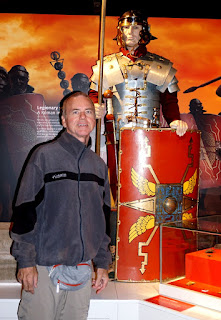June 29, 2018
This morning we took a passenger Ferry to the Orkney Islands, an archipelago of dozens of islands off the far northern tip of Scotland. Luckily for our weak stomachs the notorious Pentland Firth was almost a sheet of glass.
On the Orkneys, we board a tour bus. The bus hops a chain of flat treeless islands linked by man-made causeways. In the center is a sheltered body of water known as Scapa Flow. This natural harbor is famous for being a major British naval base during WWI and WWII. The causeways are known as the Churchill Barriers. They were constructed after a German U-boat snuck into the harbor and torpedoed a British navy ship in the initial months of WWII. Churchill ordered the barriers constructed from scuttled ships and concrete blocks. Scapa Flow today is a major North Sea oil terminal.
Our first stop is in the capital city of Kirkwall. We first tour St. Magnus church that towers over the city. It was built from red sandstone in the 12th century in the medieval Romanesque style during Norse rule. I am surprised to find such an old impressive church in such a remote location.
Across the street we visited the Kirkwall Museum. Its main focus is the procession of cultures that have inhabited the islands for thousands of years from Neolithic to Celt to Viking to Norse to Scot.
Our next stop was for lunch in Stromness, Orkney's Second City.
After lunch we began our tour of the World Heritage "Heart of Neolithic Orkney". Today an Orkney summer day is topping out in the low 50’s. Five thousand years ago, during the Holocene Optimum, the northern reaches were a much warmer and inviting place. Orkney has many prehistoric sites. Our bus stops at the most famous, Skara Brae. Considered the Scottish Pompeii, it was buried in sand until a storm uncovered it. It is the most complete Neolithic village in Europe, older than the pyramids. Skara Brae is a cluster of eight underground houses, connected by tunnels next to a beautiful beach. The complex looks perfect for Hobbits. Considering this area is regularly battered by storms, underground homes make sense. One of the houses is unusually intact with stone bed frames, rock shelves, open hearth, and relic niches. They even had little aquarium pits for raising fish bait.
Our next stops were at the Ring of Brodgar and the Standing Stones of Stenness. Both are Stone Circles less than a mile away from each other. Brodgar is the third largest circle in Britain, 340 feet in diameter. Stenness is the oldest henge, but only four of twelve massive stones remain. Between the circles is the Ness of Brodgar that is a hotbed of archeological activity. More discoveries are clearly forthcoming.
We finished our Orkney tour at the Italian Chapel. It was constructed by POW prisoners held here during WWII.
Back on the ferry, we didn't return to our John O’Groats hotel until almost 8pm. We are exhausted. Touring is hard work especially in the far northern hemisphere where the sun barely sets below the horizon. It is hard to sleep with the sun shining all night.



















































